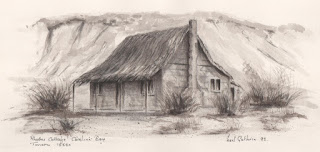Gone but not forgotten
Gone but not Forgotten
Many years ago I was fortunate to spend a
few days over a Christmas break with members of our family, who lived in
Eastern Southland, namely, Wyndham.
About eight kilometres south
of this modest farming community, the once busy hamlet of Glenham lay in a
shallow sun soaked valley. A place we
later returned to live for five short years, and a place our family learned to
love with all our heart.
Here I sketched an old country
store, still standing at the time and a short distance from our home. This store played an important role in the
development of a once thriving township.
As well as being a general store, there was a space at the western end
of a long veranda, where a butcher once practiced his trade.
The store, so I believe, was
erected by D.C.McKenzie, a local building contractor I 1908.
Only a short distance to the
east, a small red brick Presbyterian Church remained and drew a small, but
faithful congregation regularly each month.
These two structures, apart from the existence of two or three homes,
are the only visible signs that a prosperous village ever existed in this
delightful valley.
It is hard to believe now, but
Glenham became the terminus for the Edendale to Glenham railway line. Of course originally, that line had been
planned to extend much further into the countryside. However, improvements to roading and the development of more
modern transport, proved to be the beginning of the end, for this extension.
A dairy
factory, so I am told, stood about one hundred metres to the south of the old
store, while a telephone exchange was conducted from the home of a railway
ganger and his family. Of course the
public hall, the school and railway station, were but a few of those amenities
that made up this once blossoming frontier township.
As I flew past this old store
in my humble VW, on my way to work in Invercargill each morning, it never
ceased to fascinate me. Always meaning
to stop and sketch it one day, I never seemed to get a round to it.
However, given an opportunity
one weekend to wander through the old place, I decided to sketch it, there and
then.
Apart from some of the
interior being used for storage
much of the old shelving and wooden
counters were still in place. Some of
the less popular products though, they still sat where they had been left many
years before.
Memories of a by gone era
flashed before me as I wandered about.
Images of a storekeeper in my old village flashed before me. With a tin scoop, he measured an order of
sugar from a Hessian bag behind the counter.
A roll of cured bacon, draped in mutton cloth and hanging from the
ceiling, waiting to be taken down and sliced as you waited.
Boxes of dried fruit, raisins,
sultanas, apricots, dragged out from behind the counter where the storekeeper
used to dig out an order from a wooden box with a sturdy tin scoop. Now, that was not yesterday.
Mr A. C. Bulling took over
this general store and butchers shop on February 1st, 1930, however,
after sixteen years, it appears he retired and his two sons Frank and Morrie
succeeded him on August 1st 1946.
They traded as F and M
Bulling, expanding the business by making home deliveries as far away as
Fortrose on the southern seacoast, as well as home deliveries to Waimahaka,
Gorge Road, Titiroa, Te Peka, and Pine Bush.
Unfortunately, a
migration of the southern rural population to the north, or to the cities, saw
trade fall away, forcing the closure of F and M Bulling in 1972. Once more, national statistics could chalk
up yet another vanishing village to their mounting catalogue.
On Facebook. Plow and Pickle Press



Comments
Post a Comment